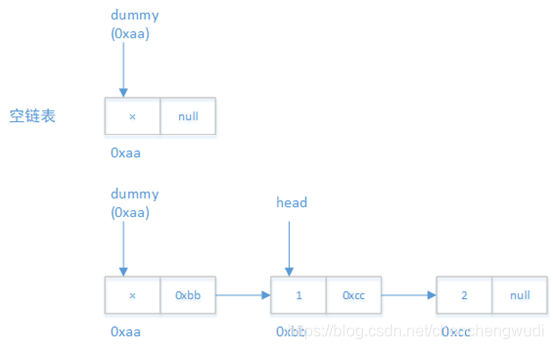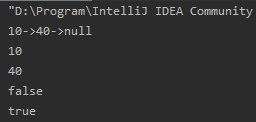九章基础算法01:链表
本文共 3385 字,大约阅读时间需要 11 分钟。
目录
1. 链表概述
1.1 链表构成

① 链表是由节点构成的列表
② 链表是一种线性数据结构
1.2 dummy节点引入

在实现链表时,可以在第1个有效节点之前增加dummy节点,
① 当链表为空时,dummy节点指向null
② 当链表非空时,dummy节点指向链表的第0个节点(从0开始计数)
1.3 dummy节点作用
增加dummy节点后,链表中的所有有效节点就都有了前驱节点,进而可以用统一的方法处理所有有效节点,而dummy引用无需修改
e.g. 在第0个节点之前插入节点 / 删除第0个节点
说明:作为对比,如果没有dummy节点,只有head引用,
① 当链表为空时,head引用为null
② 当链表非空时,head引用指向第0个节点
那么在遍历链表 / 增加节点 / 删除节点时,均需要判断head引用的状态,针对不同的情况进程处理
2. 链表基础实现
说明:基础实现并不完备,仅为示例,并未考虑异常处理
2.1 节点类型
class ListNode { public int val; public ListNode next; public ListNode(int value) { val = value; }} 说明:以示例中的构造函数新建ListNode对象时,节点的next引用默认值为null
2.2 链表类型与构造函数
public class LinkedList { // dummy节点 private ListNode dummy; public LinkedList() { // dummy节点的值此处并无实际用途,可任意设置 dummy = new ListNode(-1); // dummmy.next初始值为null,表示空链表 }} 2.3 add方法实现
// location:要插入的链表位置(从0开始)// val:要插入的链表值public void add(int location, int val) { // 我们实现为插入location节点之前,即新加入的节点占据location位序 // 所以要找到location的前驱节点 ListNode pre = dummy; // 在有dummy节点的情况下,从dummy节点开始, // 向后移动location个位置,pre即指向location的前驱节点 for (int i = 0; i < location; ++i) { pre = pre.next; } // 生成并插入新节点 ListNode node = new ListNode(val); node.next = pre.next; pre.next = node;} 说明:在插入新节点的过程中,如果location为0,则会改变dummy节点的next域,但是不会改变dummy引用的值,这也正是引入dummy节点的意义
2.4 remove方法实现
// location:要删除的节点位序(从0开始)public void remove(int location) { // 删除location节点也要查找location的前驱节点 ListNode pre = dummy; // 在有dummy节点的情况下,从dummy节点开始, // 向后移动location个位置,pre即指向location的前驱节点 for (int i = 0; i < location; ++i) { pre = pre.next; } // 删除location节点 // Java有垃圾回收机制,不用专门释放被删除的节点 pre.next = pre.next.next;} 说明:在删除节点的过程中,如果location为0,也会改变dummy节点的next域,但是不会改变dummy引用的值,这也正是引入dummy节点的意义
2.5 get方法实现
// location:要获取的节点位序(从0开始)public int get(int location) { // cur指向第0个节点(如果存在的话) // dummy.next就是head引用 ListNode cur = dummy.next; for (int i = 0; i < location; ++i) { cur = cur.next; } return cur.val;} 2.6 contain方法实现
// val:要判断是否在链表中存在的链表值public boolean contain(int val) { // cur指向第0个节点(如果存在的话) // dummy.next就是head引用 ListNode cur = dummy.next; // 遍历链表 while (cur != null) { if (cur.val == val) { return true; } cur = cur.next; } return false;} 2.7 print方法实现
public void print() { // cur指向第0个节点(如果存在的话) // dummy.next就是head引用 ListNode cur = dummy.next; // 遍历链表 while (cur != null) { System.out.print(cur.val + "->"); cur = cur.next; } System.out.println("null");} 2.8 测试用例
public static void main(String[] args) { LinkedList list = new LinkedList(); list.add(0, 10); list.add(1, 20); list.add(2, 40); list.remove(1); list.print(); System.out.println(list.get(0)); System.out.println(list.get(1)); System.out.println(list.contain(50)); System.out.println(list.contain(40));} 测试结果如下图所示,

3. ArrayList & LinkedList算法时间复杂度对比

补充:LeetCode背后的工作
LeetCode中的解题环境一般如下图所示,

环境中会定义一个Solution类,并定义题解函数,解题过程就是填充这些函数
LeetCode会以如下方式执行代码,现以求解两数之和进行模拟
public class Solution { // 题解函数 public int aplusb(int a, int b) { // 题解过程 return a + b; } // 环境提供的构造函数 public Solution() { // 构造函数体 } // 以测试用例为参数,运行题解函数 public static void main(String[] args) { Solution solution = new Solution(); System.out.println(solution.aplusb(10, 20)); }} 转载地址:http://ahwx.baihongyu.com/
你可能感兴趣的文章
nginx反向代理
查看>>
nginx反向代理、文件批量改名及统计ip访问量等精髓总结
查看>>
Nginx反向代理与正向代理配置
查看>>
Nginx反向代理及负载均衡实现过程部署
查看>>
Nginx反向代理是什么意思?如何配置Nginx反向代理?
查看>>
nginx反向代理解决跨域问题,使本地调试更方便
查看>>
Nginx反向代理配置
查看>>
Nginx启动SSL功能,并进行功能优化,你看这个就足够了
查看>>
nginx启动脚本
查看>>
Nginx在Windows上和Linux上(Docker启动)分别配置基本身份认证示例
查看>>
Nginx在Windows下载安装启动与配置前后端请求代理
查看>>
Nginx多域名,多证书,多服务配置,实用版
查看>>
nginx如何实现图片防盗链
查看>>
Nginx学习总结(13)——Nginx 重要知识点回顾
查看>>
Nginx学习总结(14)——Nginx配置参数详细说明与整理
查看>>
Nginx安装与常见命令
查看>>
Nginx安装及配置详解
查看>>
Nginx实战经验分享:从小白到专家的成长历程!
查看>>
Nginx实现反向代理负载均衡
查看>>
nginx实现负载均衡
查看>>